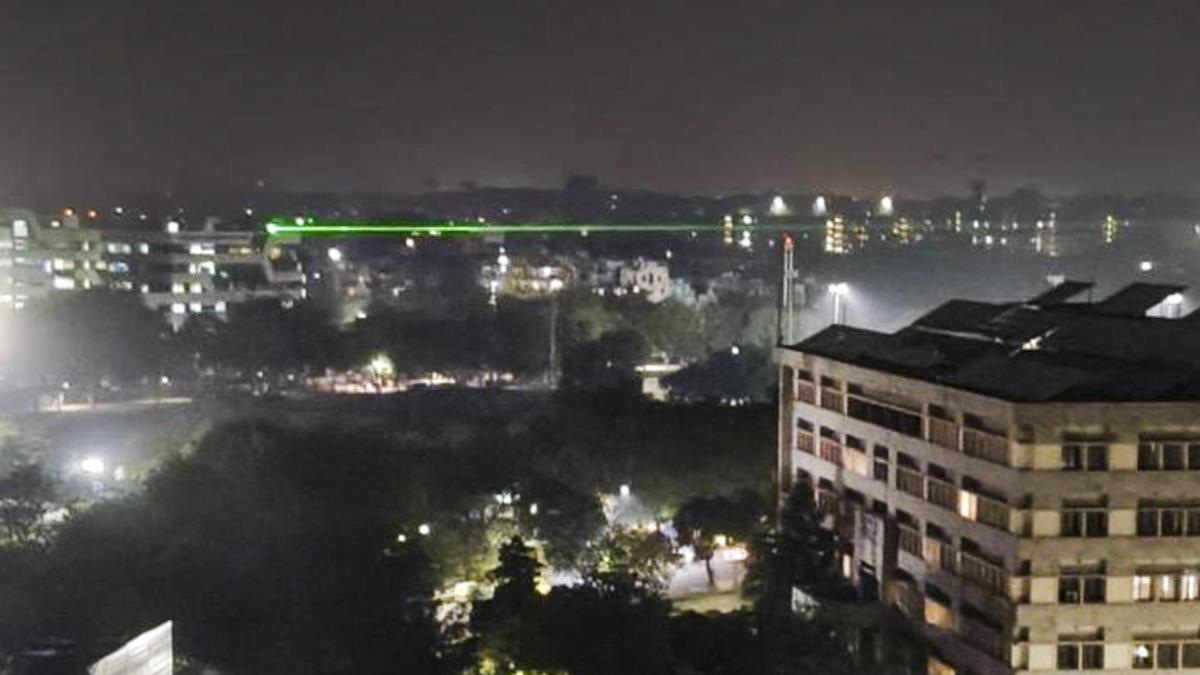IIT-Delhi and DRDO scientists have successfully demonstrate entanglement-based free-space quantum communication over 1 km.
| Photo Credit: X.com/@SpokespersonMoD
The story so far: On June 16, the Ministry of Defence said in a statement that IIT-Delhi scientists together with the Defence Research and Development Organisation (DRDO) demonstrated quantum communication over a distance of more than 1 km in free space. The development was hailed as a breakthrough in quantum cybersecurity.
What is quantum communication?
When two or more photons, the subatomic particles of light, are created in just the right way, measurements made on one photon will instantly determine the result for the partner photon, too — even if the photons are far apart. This phenomenon is called quantum entanglement. Ordinary or classical physics can’t explain this correlation, it’s a purely quantum phenomenon.
Quantum communication is an umbrella term for any scheme that uses the concepts of quantum physics, but especially entanglement, to make a given communication channel leak-proof. In one scheme, like the one the IIT-Delhi team demonstrated, entangled photons carry information from a source to two stations. If any third party intercepts one of the photons, the other photon will immediately be disturbed as well and the channel will be revealed as insecure.
In short, quantum communication can be used to create communication channels that are protected against computational attacks since any attempt to tap the quantum channel will itself be revealed. Thus they have great value in defence settings.
An important method in quantum communication is quantum key distribution (QKD).
How does QKD work?
If Bala has a message for Selvi that he wants only Selvi to receive, a simple way is to send a letter. At the address, the postal worker will deposit the letter into a letterbox. The location of the letterbox is public knowledge, but only Selvi will have the key to access it. The key is private knowledge.
Receiving email works similarly: Bala will send an email to Selvi’s email ID (public knowledge) and Selvi will use her password (private knowledge) to access it.
QKD is a specialised form of quantum communication whose sole purpose is to help Bala and Selvi possess identical secret keys. Once they both have the key, they can unlock and read the messages they send each other.
Note that QKD doesn’t encrypt the message itself: that’s achieved using traditional algorithms like AES. Instead QKD helps both parties acquire the key to unlock that encryption in a secure way.
There are two kinds of QKD. In the classic prepare-and-measure way, Bala prepares single photons in some predetermined states and Selvi measures them. In entanglement-based QKD, a source creates entangled photon pairs and sends one photon to Bala and the other to Selvi.
What did the IIT-Delhi team do?
The IIT-Delhi team, led by Prof. Bhaskeri Kanseri, transmitted keys through the air using entanglement-based QKD, across a distance of 1 km in the IIT campus. This is a step up from transmitting photons through an optical fibre. The greater goal here is to establish reliable QKD between a ground station and a satellite orbiting the earth hundreds of kilometres up. This way the satellite can distribute keys to receivers anywhere in India by beaming photons through the atmosphere.
Notably, the test demonstrated “a secure key rate of nearly 240 bits per second with a quantum bit error rate of less than 7%”. When the photons reach Bala and Selvi, they will measure each particle. Since they’re entangled, the measurements have to match up. In this case the measurements disagreed <7% of the time, which is considered acceptable for the present scheme. Common sources of error include turbulence in the air, detector noise, and artificial lighting.
Previously, Prof. Kanseri’s team had demonstrated a quantum communications link between Vindhyachal and Prayagraj in Uttar Pradesh in 2022. The year after, they increased the distance to 380 km with a spool of standard telecom fibre and a quantum bit error rate of 1.48%. In 2024, they established a QKD scheme through more than 100 km of an optical fibre link.
What next?
The IIT-Delhi team demonstrated the technology in the presence of dignitaries from the DRDO, the institute, and the Directorate of Futuristic Technology Management, including the director of the DRDO-Industry-Academia Centre of Excellence at the IIT.
After the event, Minister of Defence Rajnath Singh said India had “entered into a new quantum era of secure communication which will be a game-changer in future warfare.” These changes entail a quantum network with multiple nodes maintaining quantum communications. In 2021, China created the world’s first quantum network with two ground-to-satellite links and optical fibres together covering 4,600 km.
Quantum communications has important civilian applications too, especially in the banking and telecom sectors.
A future ‘quantum internet’ of the sort the U.S. expects to possess by the mid-2030s could also enable distributed quantum computing, ultra-precise sensing, and network-wide secure time synchronisation in addition to secure messaging. To help scientists develop such technologies, the Indian government approved the National Quantum Mission in 2023 with an outlay (2023-2031) of Rs 6,000 crore.
Published – June 18, 2025 07:00 am IST
